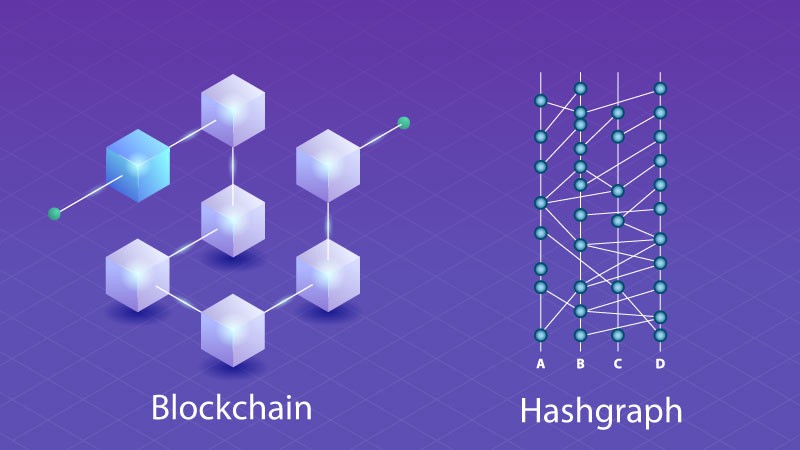The loud emergence of Bitcoin marked the introduction of blockchain technology to the world. Not only bitcoin, cryptocurrencies that emerged as a new and novel monetary network, using decentralized control instead of centralized controls made the worldwide adoption of decentralized blockchain technology inevitable.
As blockchain entirely relies on the peer-to-peer network, it has been a reliable business model for enterprises for years.
With Distributed Ledger Technology, businesses can harness computing power like never before.
Blockchain is remarkable. Still, multiple reasons like scalability, and interoperability have restricted blockchain adoption across enterprises.
Amid all the decentralized blockchain technology restrictions, Hashgraph comes as an alternative to it.
Being founded by Leemon Baird, Hashgraph comes with features like security, speed, and more. It is evident that confusion like hashgraph vs blockchain is rising in people’s minds.
Technologists and companies worldwide have been considering blockchain development as the most disruptive innovation. The potential of blockchain applications is endless.
However, Hashgraph is also consistently gaining popularity when it comes to seamless online transactions. Is there a war like a hashgraph vs blockchain out there?
Whatever there is, no need to worry about that. In this blog, we will try to provide you with a deep insight into the efficacy of blockchain and hashgraph to let you understand, which one is the best for you.
An Intro to Distributed Ledger Database
We can not straight dive into hashgraph vs blockchain. We must go there step by step. And the first step is to understand Distributed Ledger Database.
A Distributed Ledger Database (DL) or Distributed Ledger Technology (DLT) refers to a digital ledger of transactions or shared contracts, synchronized and stored in a decentralized way across different geographical locations and computer systems.
A DL stores this information securely and immutably using cryptographic techniques. t means that it is much more difficult to tamper with the data or attack it.
This is because all the nodes in a DL would need to be attacked and manipulated simultaneously for any changes to be made.
Both blockchain and Hashgraph leverage different kinds of data structures and mechanisms to maintain Distributed Ledger Database.
What is Blockchain Decentralized technology?

A clear understanding of blockchain technology will make us one step closer to hashgraph vs blockchain.
Blockchain is a distributed ledger technology. Companies use it to track transactions and maintain records.
It is a shared database that everyone on the network can see and verify. The blockchain can keep running on multiple computers, and it records each transaction between two parties.
Blockchain systems stores the data in blocks. It links all those blocks together using cryptography forming a chain of blocks.
This network of linked computers uses its processing power to verify transactions and to approve the addition of a new block.
The data stored in the blockchain is impossible to hack or alter.
So, decentralized blockchain technology is immutable.
See More: Blockchain Trends
The Consensus Mechanisms of Blockchain
The understanding of the mechanism of blockchain is the prime aspect that can help a business understand hashgraph vs blockchain.
Multiple consensus mechanisms are the pillar of decentralized blockchain technology.
1. Proof of Work
The process of bringing a consensus to the network and securing the blocks is done by solving puzzles through computation, which is also known as mining.
The nodes of the network are known as miners, and their job is to validate transactions and add new blocks. They win rewards for each puzzle they solve.
2. Proof of Stake
This system works by choosing a creator/validator to verify and add blocks to the Blockchain. They get chosen based on their contributions to the network.
This helps to ensure that only the most trustworthy and active members can add new information, keeping the Blockchain accurate and reliable.
3. Proof of Elapsed Time (PoET)
The mechanism works like a lottery system to stop the network from using too much energy and resources. In this system, everyone who wants to join the network has to first identify themselves.
This makes it so that everyone has an equal chance of winning, and it is often used for permissioned networks.
4. Leader-oriented Consenseus
This mechanism is called "leader-based consensus" because a single computer, called the leader, is responsible for validating and adding transactions to the blockchain.
Transactions first go to the leader, who then broadcasts them to the network. Other computers in the network verify that the transactions are valid and add them to the blockchain.
5. Economy-based Consensus
This mechanism relies on the concept of economic rationality to reach a consensus, as real-world economies function without chaos.
In this system, you vote to add blocks, and you may have to pay a fine if you vote for a block that no one else voted for.
Similarly, you could earn a profit if you vote for a block that everyone else voted for.
Getting Insight into Hashgraph
Now, the final step of understanding difference between hashgraph and blockchain. And it is digging into hashgraph.
Like Blockchain technology, the foundation of Hedera Hashgraph has also Distributed Ledger Technology.
It uses a graph data structure to store information. In a graph data structure, nodes get connected and communicate with each other to store information. This information gets stored in the form of events.
Hedera Hashgraph is a Decentralized Distributed Ledger Technology that uses the Asynchronous Byzantine Fault Tolerance consensus algorithm. This algorithm makes the platform secure against attacks.
Therefore, it is a unique platform in the realm of Hashgraph development that offers features such as security, fair conditions, and high performance.
The main mechanism of Hashgraph technology relies on 'gossip about gossip' and 'virtual voting' to bring consensus to the network.
Hashgraph Vs Blockchain Technology
Since the introduction of both hashgraph and blockchain technology and is now clear, let's head straight to their comparison. Hashgraph Vs blockchain, what would you choose for your business:
1. Licensing
- Blockchain got released under the MIT license.
- Hashgraph belongs to an organization named Swirld.
2. Consensus Algorithm
Blockchain technologies rely on multiple consensus algorithms, including proof-of-work and proof-of-stake.
Proof-of-work is primarily used to protect blockchain technology, while proof-of-stake is used to replace miners with validators to authenticate transactions.
In addition to these two, blockchain also uses other consensus protocols such as proof-of-elapsed time, leader-based consensus, and economy-based consensus.
Hashgraph relies on two consensus algorithms, Gossip about Gossip and Virtual Voting.
Gossip about Gossip, a crucial component of Hashgraph development, is responsible for transmitting transaction information from one node to another.
Using Virtual Voting, each node participating in the transaction can get to know the data of other nodes, allowing the transaction priority to be decided.
3. Transaction per Second
- Blockchain systems can handle between 100 to 10,000 transactions per second.
- Hedera Hasggraph can accomplish around 500,000 transactions per second.
4. Security
- Blockchain ensures data security through cryptographic methods.
- On the other side, Hashgraph offers data security through a security protocol like Asynchronous Byzantine Fault Tolerance (aBFT).
Wrapping Up
At present both decentralized blockchain technology and Hedera Hashgraph seem as two of the most promising technologies for data security and fast transactions.
Sure they hold their limitations, but the scope is endless out there. Don’t let yourself hang in the debate like hashgraph vs blockchain.
First, you need to understand your business requirements and then decide which technology suits the best. Unless you note down your requirements, you can not make the right decision.
Are you still banging your head on the wall? Is it too difficult for you to decide whether blockchain or hashgraph? Consult with EDIIIE for better clarification.









